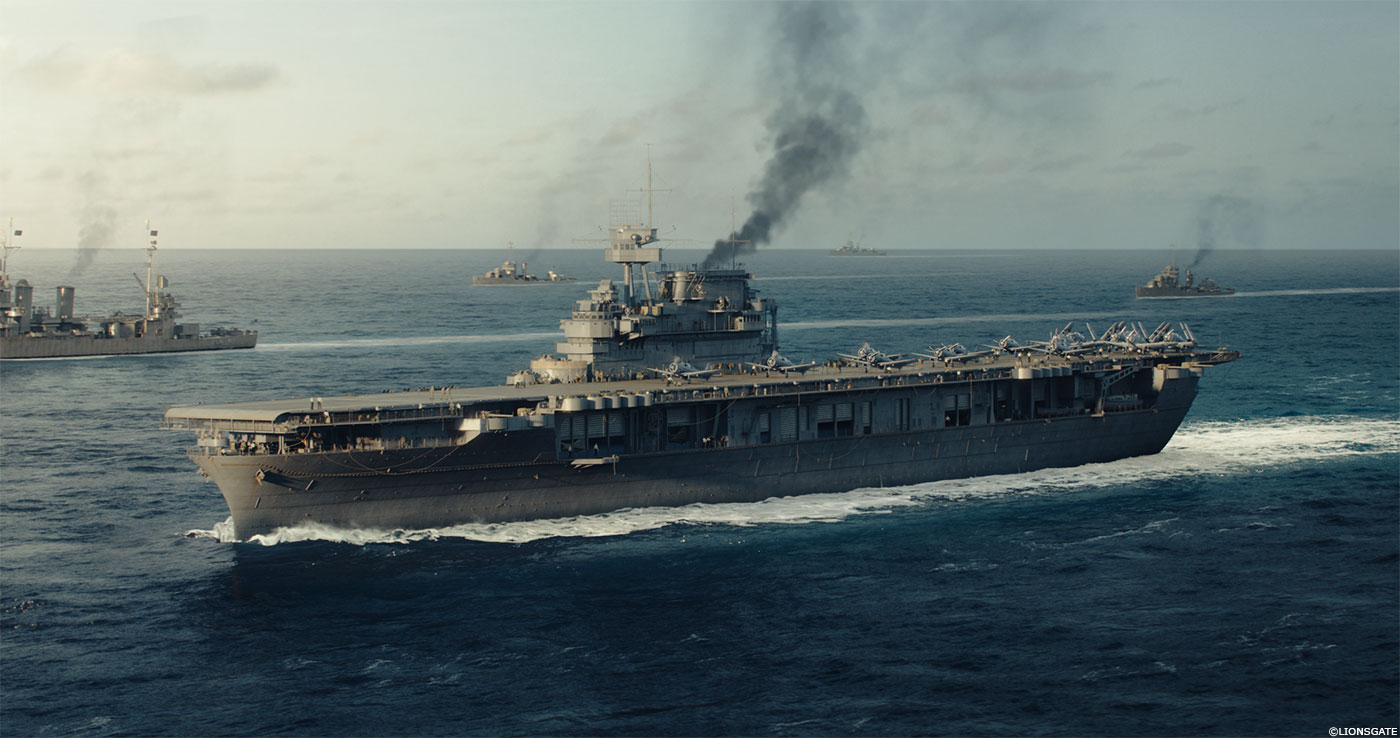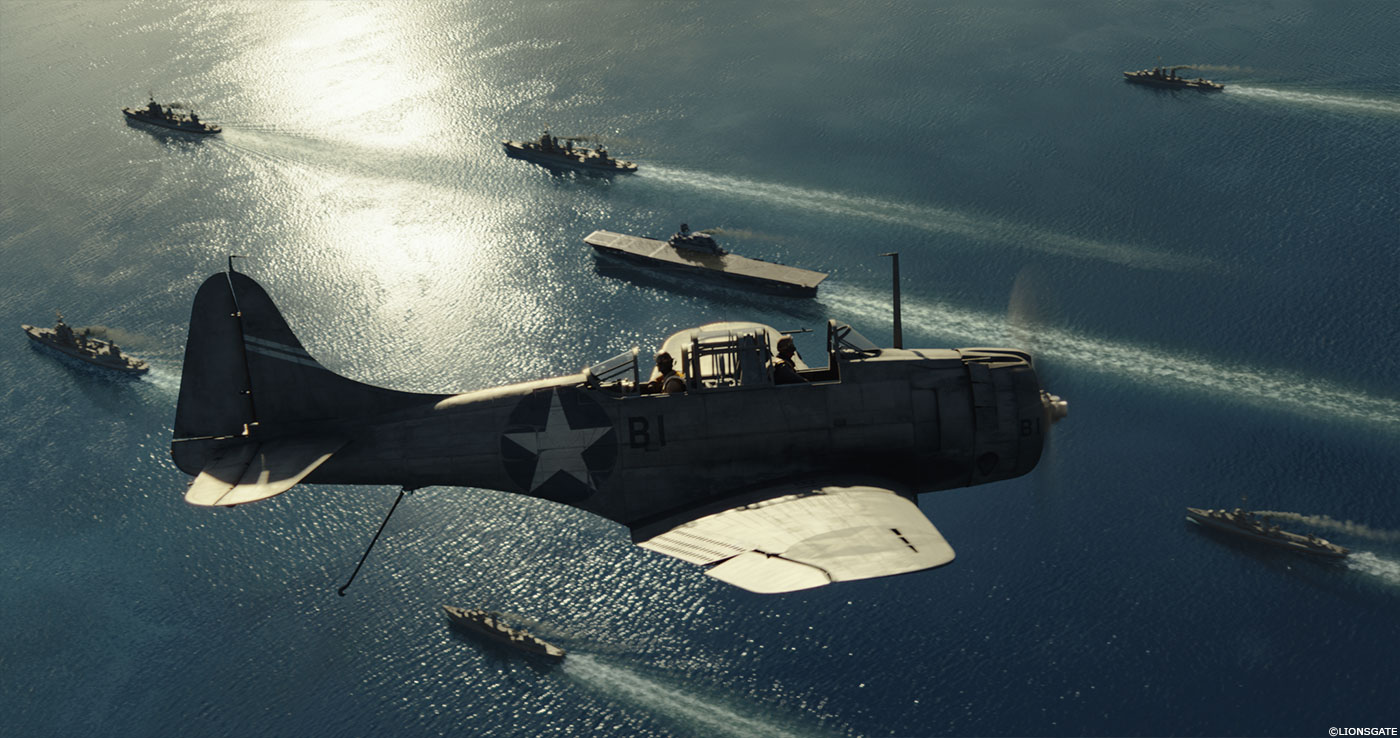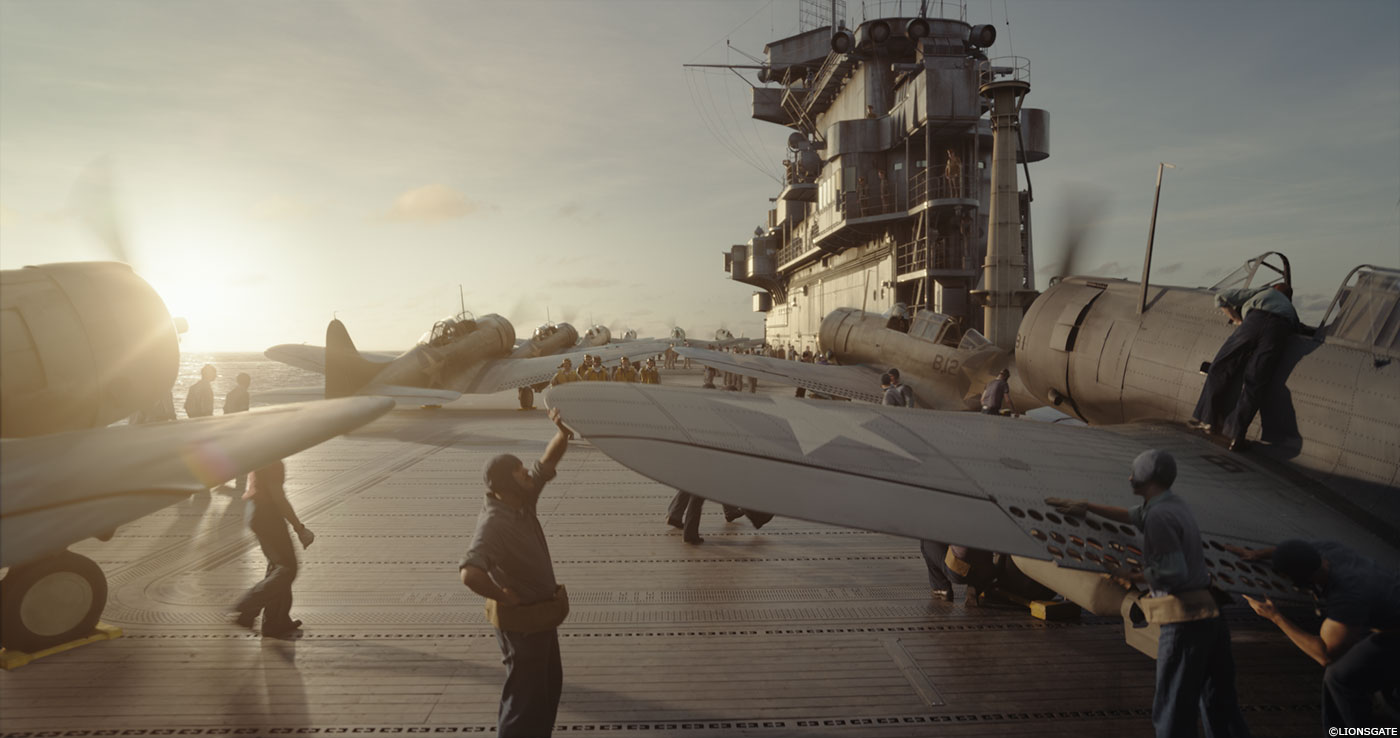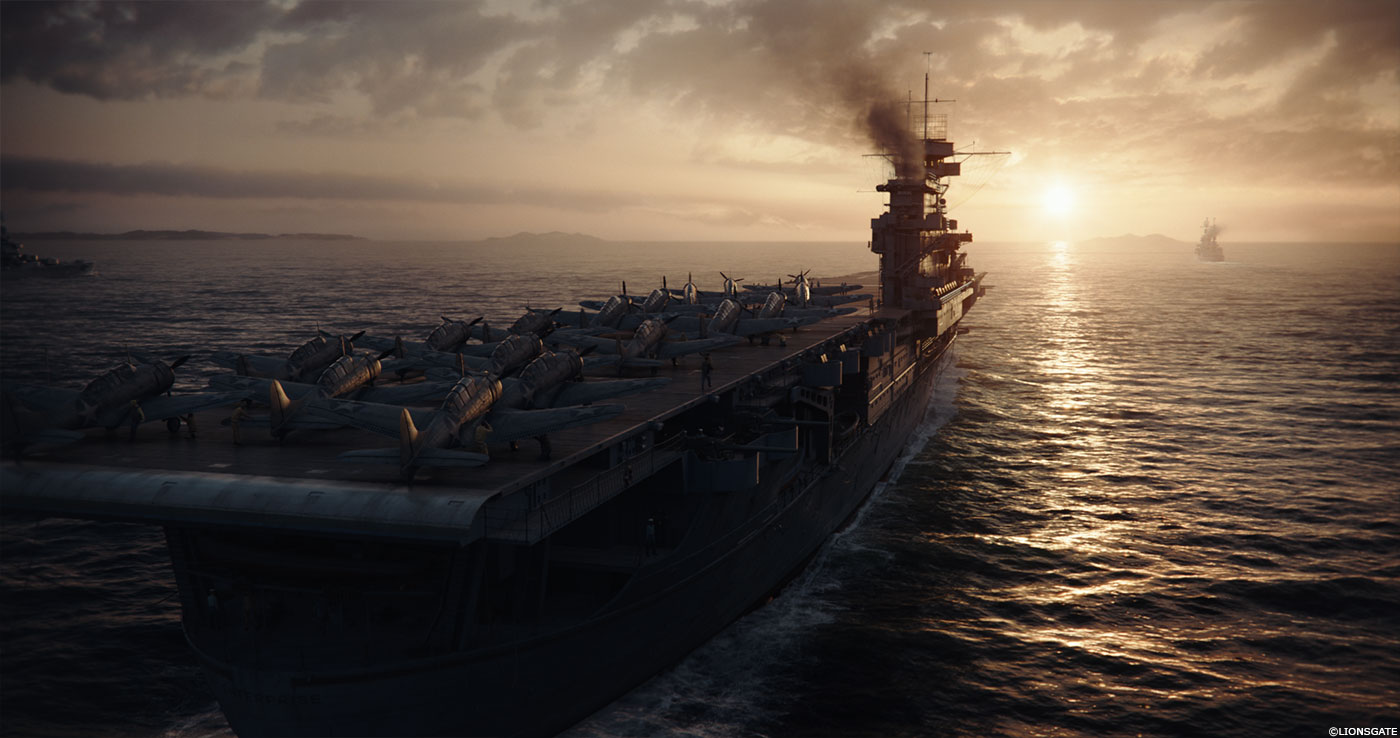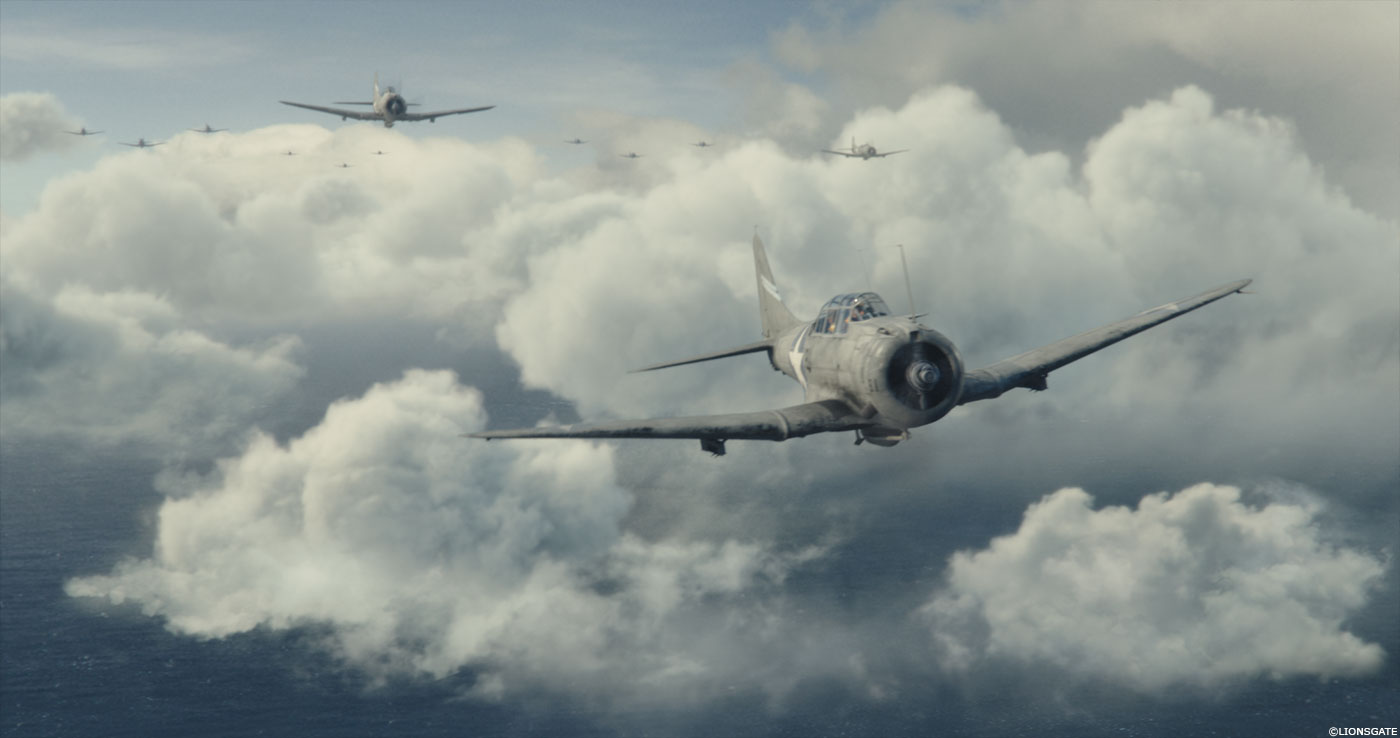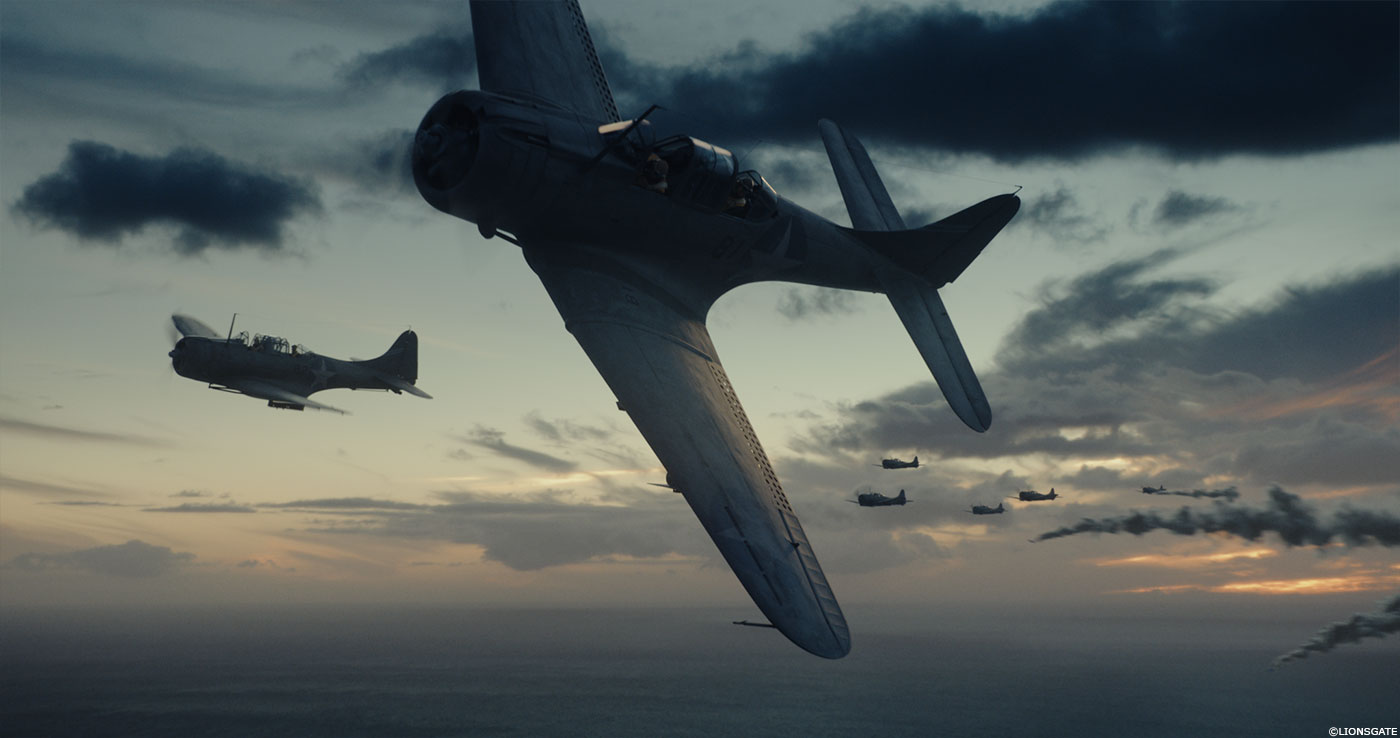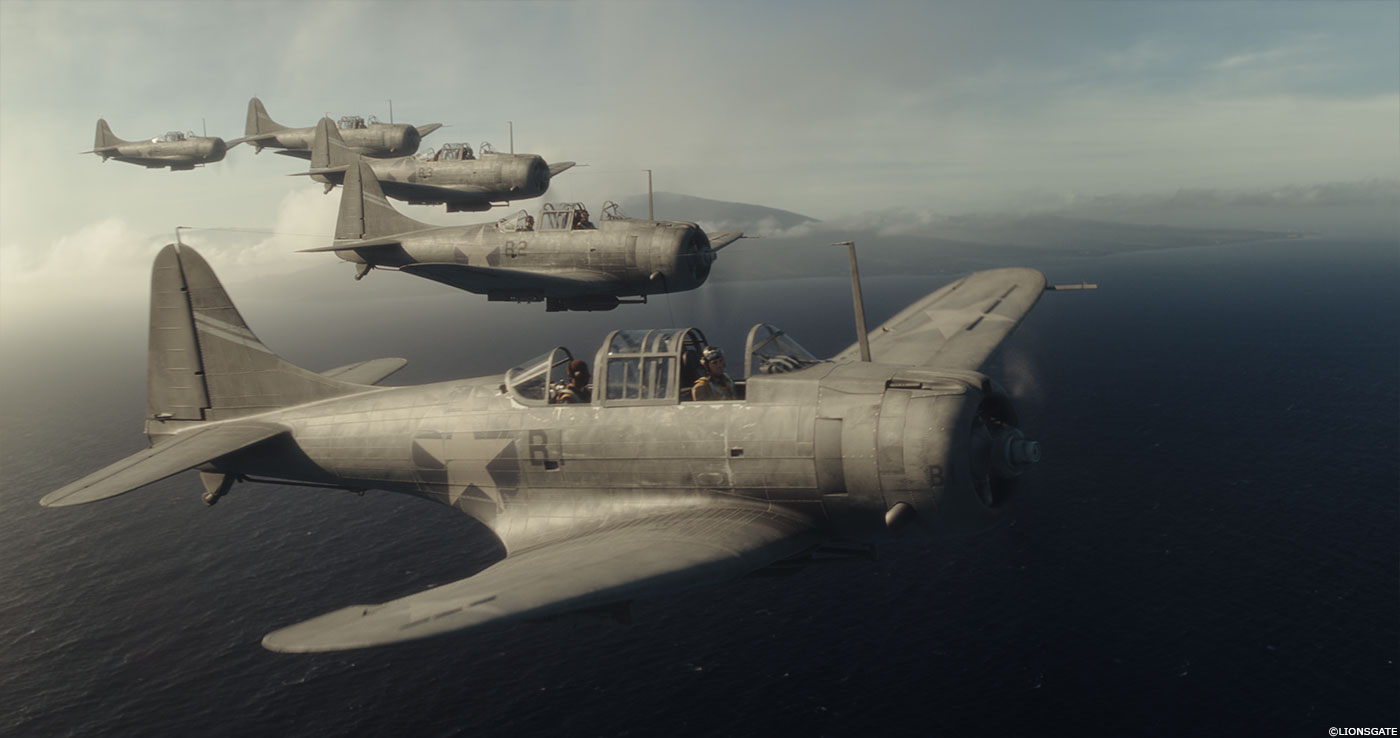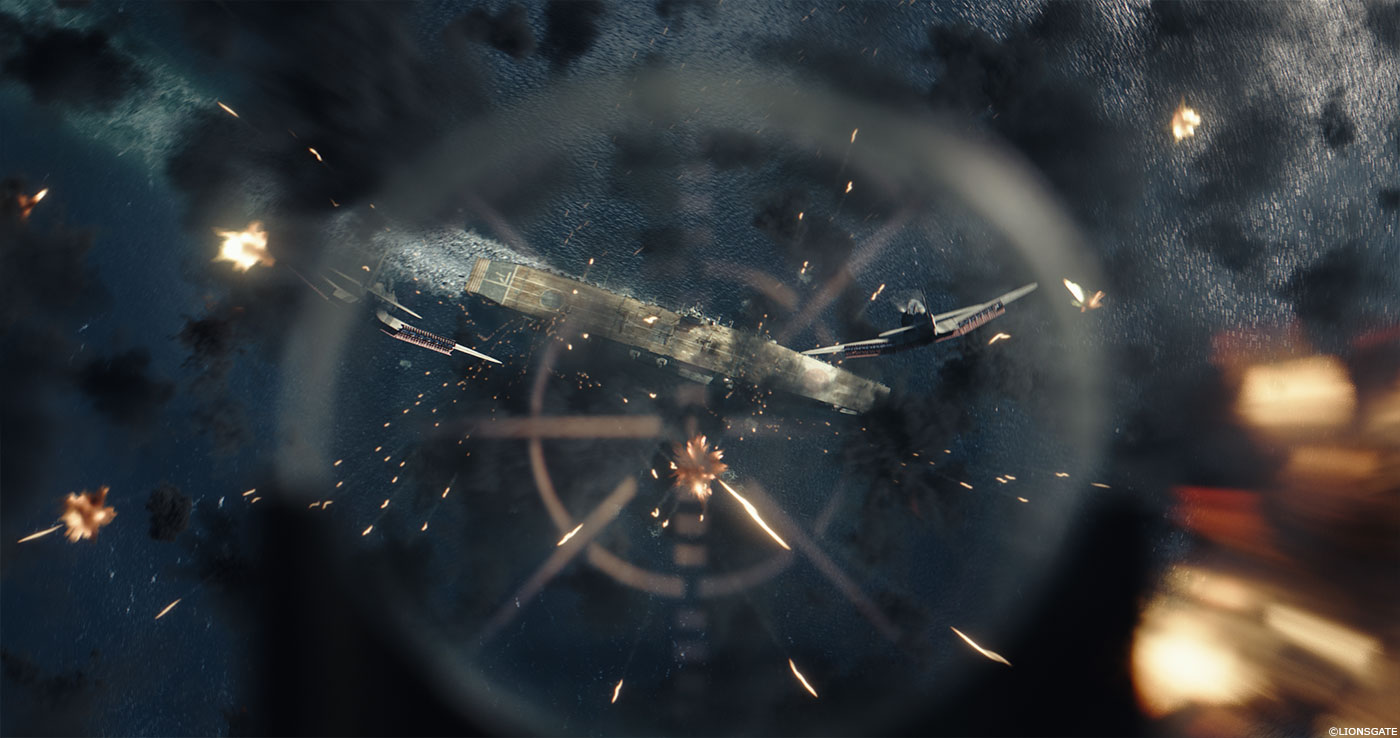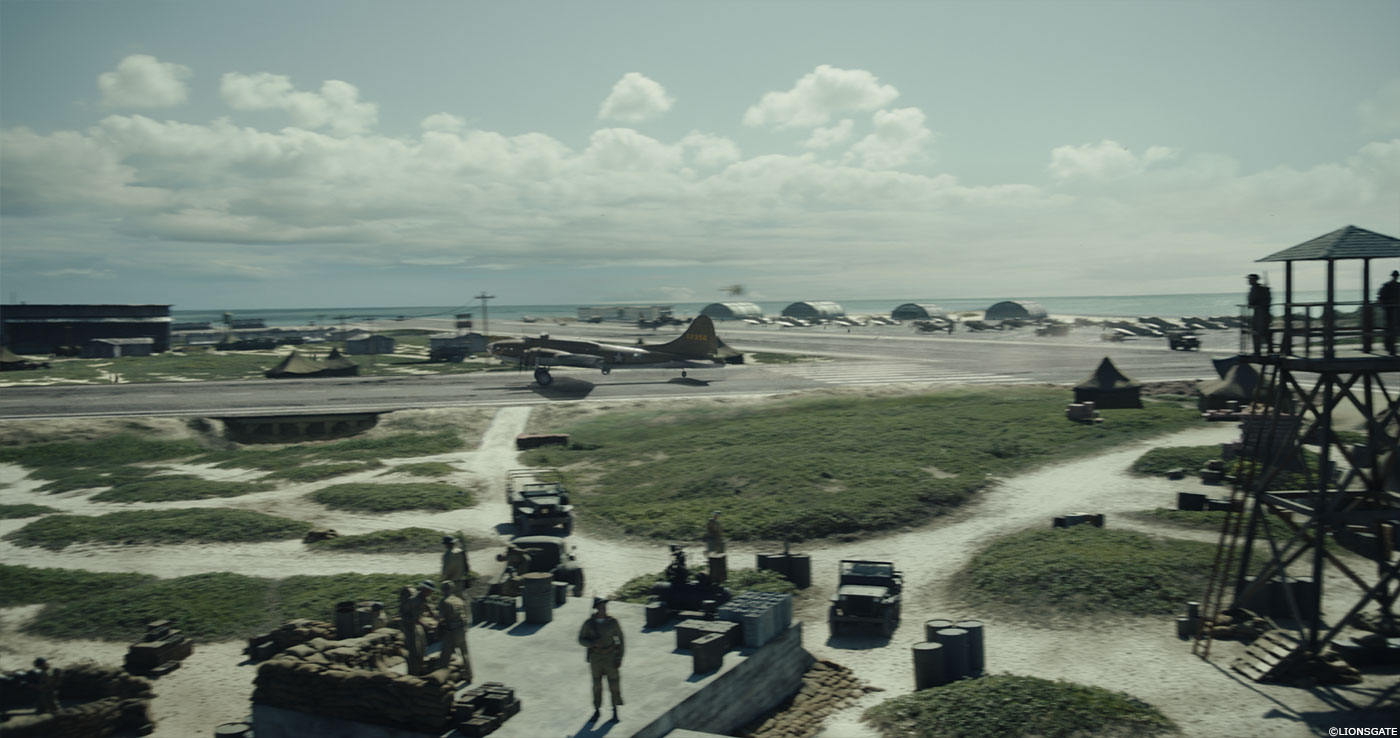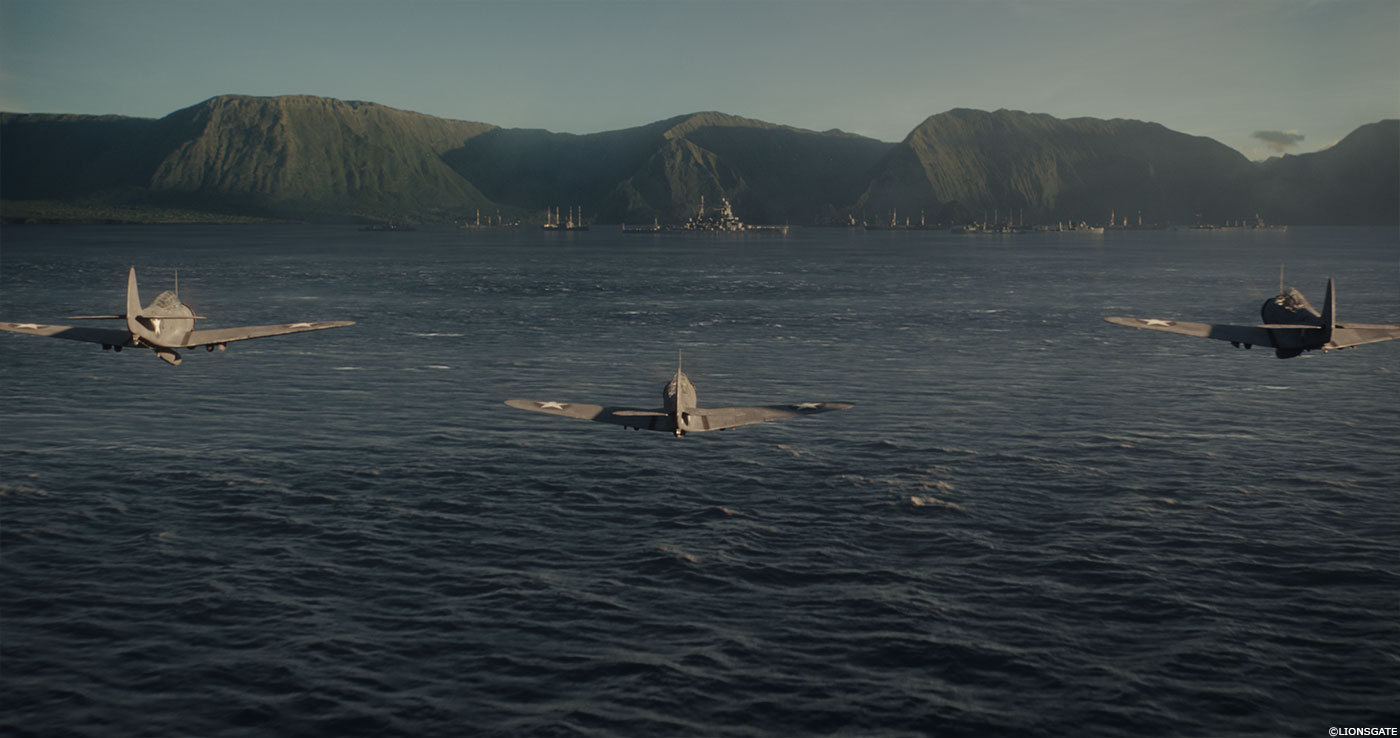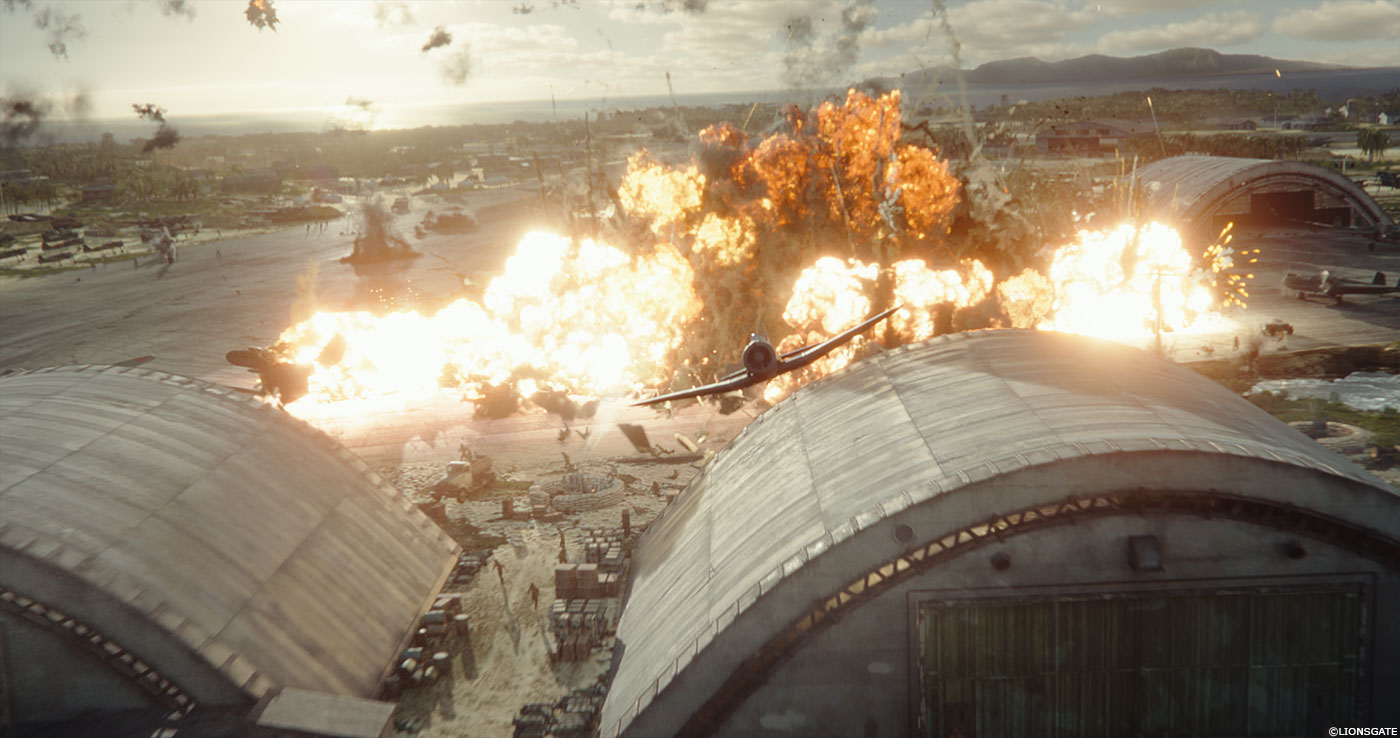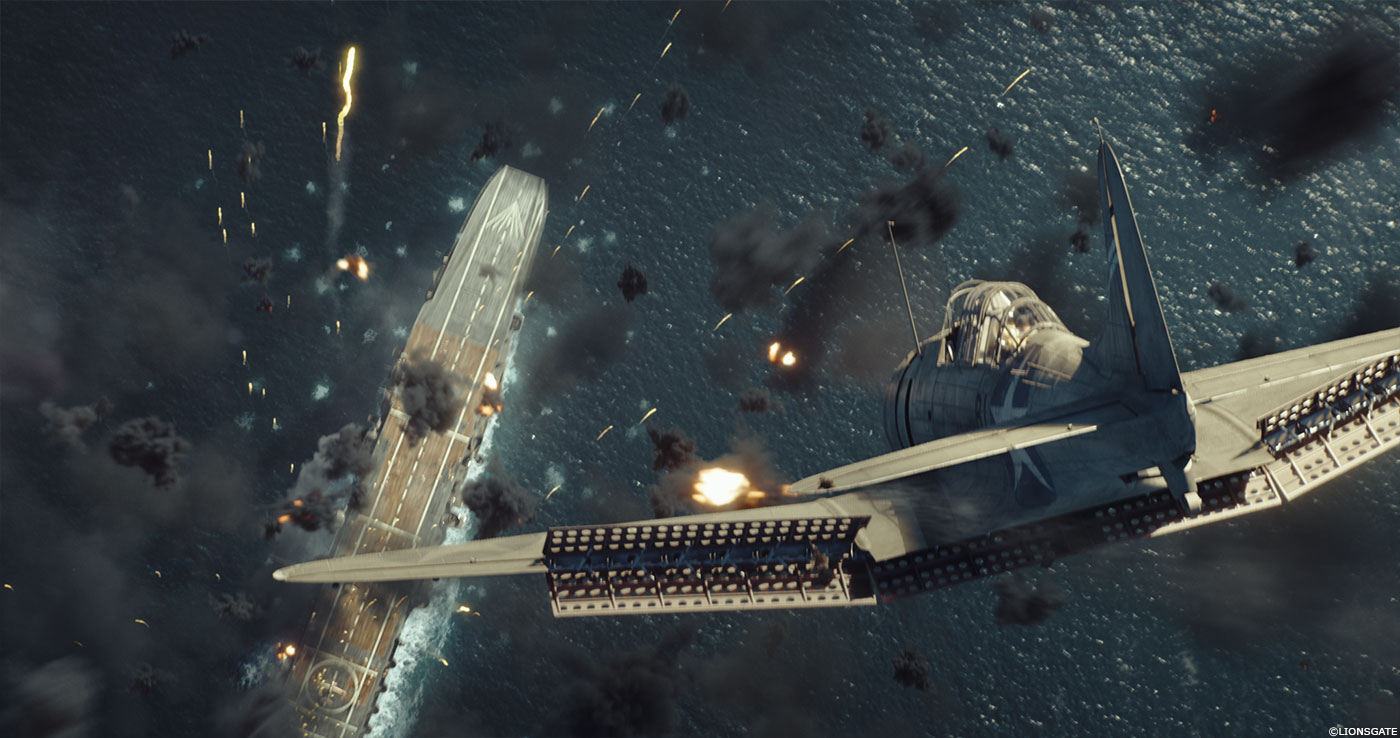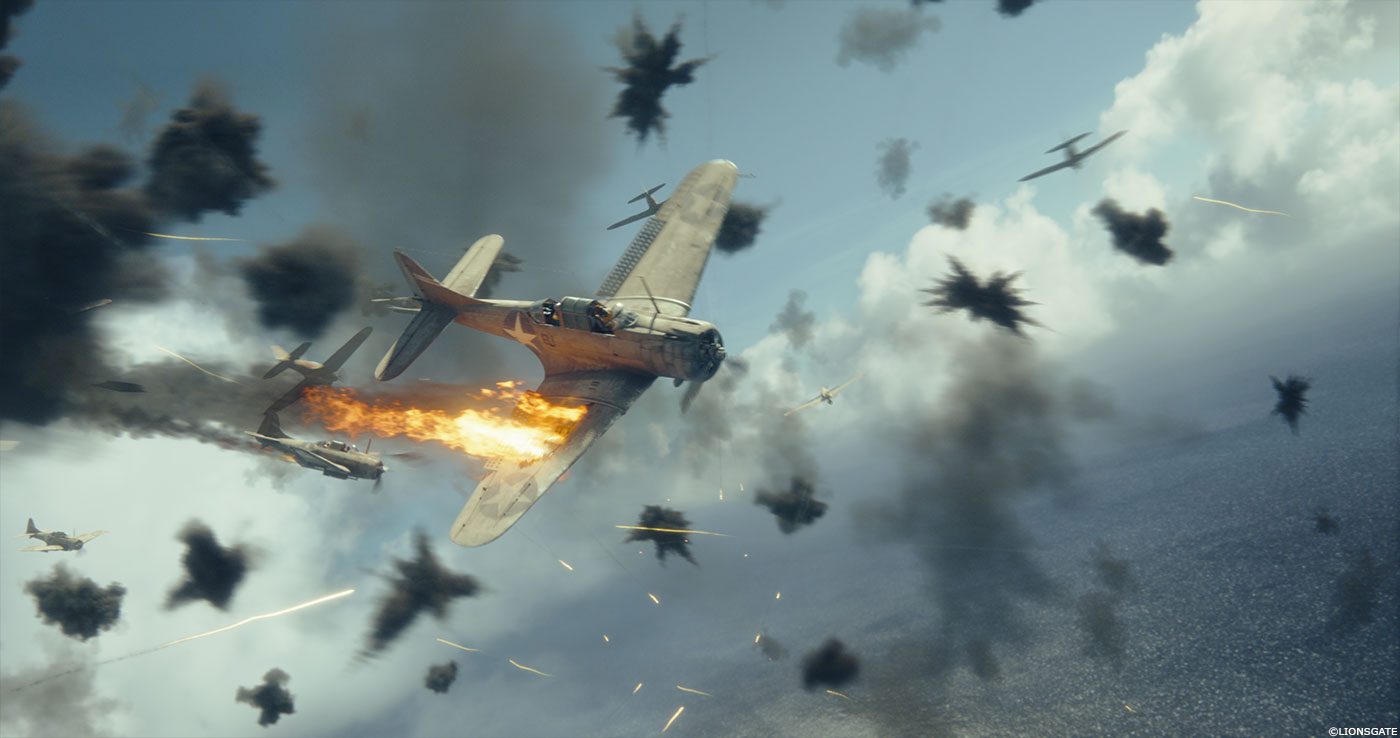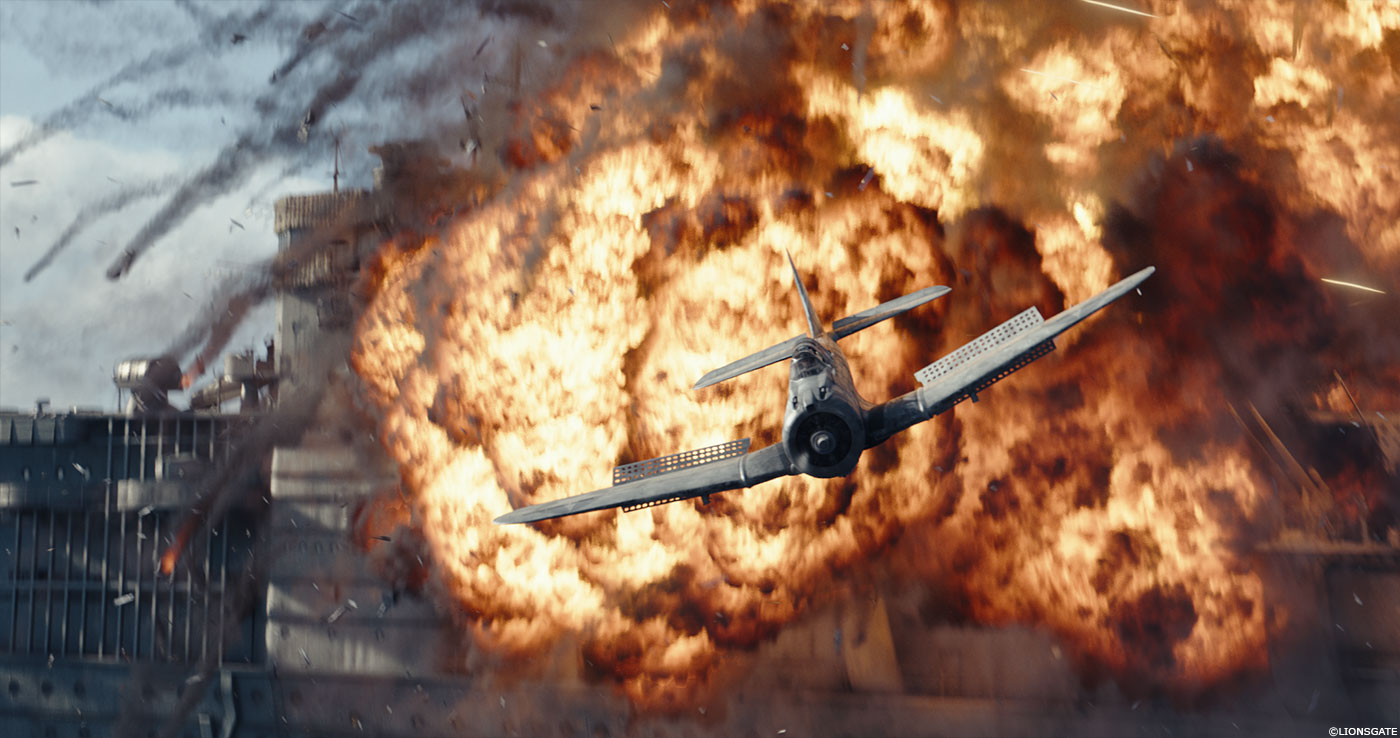The team of Pixomondo composed of Derek Spears (VFX Supervisor), Tefft Smith II (Head of Visualization) and Phi Van Le (VFX Producer) talk about their work on MIDWAY:
How did you and Pixomondo get involved on this show?
Tefft Smith II // I was actually hired by Pixomondo to advise on the pitch for the Previs and Postvis for MIDWAY. I started at Pixomondo when we won the Previs with the test we did for Roland, showing the benefits of Previs and how far we could push the quality.
How was the collaboration with director Roland Emmerich and Overall VFX Supervisor Peter G. Travers?
Tefft Smith II // We met with Roland right at the beginning. We went over all the then-planned sequences and determined what his visual visions were. He was very hands on, involved in every step. We even had a team set up at Centropolis so that Roland had day-to-day contact with us on each sequence. We had several sequences going on simultaneously, with two to three reviews every week to go over them and address all of Roland’s and the other’s notes. Another amazing thing was that Roland welcomed our input and creative suggestions. He had a clear vision of what he wanted this film to be, but the great thing was that he was always open-minded and seeking suggestions to make it the best it could be, consistent with his vision.
Phi Van Le // We were fortunate enough to have access to both Roland and Pete for most of the process. It’s rare to have almost daily feedback from a director in any project but Roland made sure he was available to help and guide us along the way. It also helped that Centropolis and Pixomondo are just located minutes away from each other so we had weekly in person visits which helped tremendously.
What was their expectations and approach about the visual effects?
Derek Spears // The expectation was as much physical and historical accuracy as we could attain while simultaneously creating an exciting cinematic experience.
Tefft Smith II // One of the main reasons why Pixomondo was brought on was because we were able to take the film sequences through the entire pipeline. We started in Previs with all the planned CG shots and animations and were able to carry them on into final renders. We worked hand in hand with Sebastian Butenberg (Pixomondo’s Animation Supervisor) on all our shots. Even though Previs is done in a fast, relatively rough manner in order to plan out how best to tell the story, it is an excellent starting point for Sebastian and his team to take it the next level of sophistication. We also planned all our shots so that the actors in the studio or on location knew what the CG was, with sufficient technical accuracy to do the best job as they were filmed. We had access to all the specs of the planes and sets, so that we could use techvis to help Roland see how certain complex shots needed to be filmed.
How did you split the work amongst the Pixomondo offices?
Derek Spears // We tried to split along lines that created stand-alone work. In order to stay efficient, we tried to eliminate overlap. Obviously, assets were going to be shared, as well as some R&D. However, we found clean breaks so that sequences did not depend on each other for continuity could be split to different facilities. That way all of our interdependencies were front loaded and allowed facilities to get into shot production without waiting.
Phi Van Le // We did our best to split the work by assets and ensure that certain offices became “experts” with a particular element. Because MIDWAY had a lot of sequences with similar assets, this was a little bit of a challenge.
What are the sequences made by Pixomondo?
Derek Spears // Our most significant sequences were the opening scene introducing Best and the Enterprise with his initial landing and the Enterprise reveal. We also had smaller sequences with Dickinson’s return to Hawaii and the search for carriers after the Pearl Harbor attack. Our other major sequences were the attack on Midway island, Midway Island’s counter-attack, the sinking of the Kaga and the Akagi, and McClusky’s dogfight on the way back to Enterprise. We also did quite a bit of work on the deck of the enterprise as well as a few deck shots of the Japanese carriers during the attack.
Tefft Smith II // Visualization handled 49 different sequences that appear in the final film. We were charged with doing the climatic, final attack scene of the Midway movie, where Best attacks and then takes out the Japanese aircraft carrier, Akagi, and is able to escape away, avoiding the hail of gun fire. Roland had used storyboards on a few key sequences, before we came aboard. This gave us a great start on our initial shot composition and edits. We were thus able to find the intense pace and complicated rhythm of each of the battles.
Can you elaborate about the previs work?
Tefft Smith II // As mentioned, we were privileged to work so closely with Roland in conceptualizing the sequences we were responsible for. We had 4 teams working on the 49 sequences: Between myself and Nate Hopkins we oversaw 3 teams in LA and 1 at Roland’s Studio, Centropolis. The key factor was having the Previs stream all the way to the finals. Our goal was to solve the challenge of telling the story as Roland envisioned it for the battle sequences, in Previs, so that once Roland approved it, it could go straight into layout, final animation, render and comp. We worked for over a year with Roland on every shot and sequence until he was satisfied that it was ready to shoot for the final picture. Since we had several sequences going on at once, we had our in-house editor, William Appleby, with us, full time. Will worked with Roland on each of the sequences to make sure they were what Roland wanted. On average, we reviewed 6 full edits each week. Not only were we refining each shot with Roland, Will was also working with Roland on the edits. Each aspect contributed to realizing the vision Roland had for telling the decisive Midway battle story. Once we had sequences in a good place, we would then turn them over to Techvis to make sure we had all the technical data Roland would need in order to shoot the scene, for real. This was really important when there were actors that needed to be in the shots. This also helped Roland fit certain sequences into his budget. We were able to preview different angles that allowed certain shots to be done in CG, without having to shoot with the actors. The final step was, after they shot principal photography, we were able to Postvis a few sequences that needed to have fast temp animation and effects added in order to lock down parts of the edit.
Where were the various sequences filmed?
Derek Spears // Midway Island was filmed in Hawaii. All of the carrier deck work was shot on stage in Montreal, as was the cockpit photography. All aerial battles and exterior ship shots are entirely digital.
Can you explain in detail about the creation of the various planes and ships?
Derek Spears // We based everything on historical reference. We even went as far as to research which ships were in the escort fleet surrounding the carriers and their disposition. We then built the classes of ships that matched those escorts and used those as the basis of the fleet. For the Enterprise, we had to build two different versions. For full CG shots, we built a period accurate version that reflected the set dressing and armament decisions made by the Art Department. Dues to size restrictions on the stage, the practical enterprise deck built was slightly narrower in order to fit on stage. We built a separate set extension version that was scaled to match the stage version.
Can you elaborate about the planes animations?
Derek Spears // Bot myself and Sebastian Butenberg are pilots. We paid particular attention to the flight dynamics (particularly Sebastian), even how the control surfaces act to cause the movement of the aircraft. Grounding it in reality was our best chance to get Roland to final shots and be happy with them.
Tefft Smith II // We spent a lot of time researching and discussing with pilots about the planes and air battle strategies that are used in “dogfights.” Sebastian Butenberg, who is also a pilot, and I went over in detail what was possible and what did not make realistic sense. I always started with Roland’s initial ideas, then we would create the shots and camera angles that best matched his vision for the story. From there, we refined everything to make it as intense, exciting and real as possible. After we had something that felt right, Sebastian and I would go over where we needed to pull back in order to make it technically realistic, given the true limitations of the types of airplanes we were animating. We then presented it to Roland explaining why we did what we did. Roland was always willing to listen as he wanted to have the film be as realistic as it could be and yet tell the intense and important story of the Battle of Midway that he wanted to portray. Usually this involved an exploration of where and what we could do to push the boundaries. The process worked great, as I feel that we achieved the objective of showing how intense and action packed the battles were, in a technically realistic way.
What kind of references and indications did you received for the planes animations?
Tefft Smith II // When we started we did a lot of research on YouTube and history books. That said, The Fighting Lady was one film that Roland constantly referred to and it served as our principal guide.
How did you handle the lighting challenge?
Derek Spears // Lighting is an important aspect to storytelling. How you light can help set a mood or tone in a scene. It is important to understand that continuity was secondary to beautiful lighting design. Roland loves dramatic lighting, most shots are 3/4 backlit. Water especially responded well to backlight, giving glitter and dramatic highlights.
Can you tell us more about the creation of the POV shots?
Tefft Smith II // This was another way for Roland to figure out what camera angles worked best. Once we had all the details of the Dauntless we were to place cameras all throughout the plane and give Roland hundreds of options. They consisted of locations on the plane and in the cockpit, as well as all kinds of lenses. After we found the right mix, we started to assemble into the edit and make sure they were used in the right locations. Roland had a clear understanding of when and what he wanted and, since we had the luxury to change locations and lenses so quickly in Previs, he could test as many as he wanted out.
Can you explain in detail about the creation of the various FX elements?
Derek Spears // We had multiple different types of effects elements. Where possible, we tried to sim once at high resolution and fidelity and then render it with the appropriate camera. For instance, the flak had a few different base sims that we would rotate and mix to make it look like hundreds of different bursts. This was also true of water hits, splashes that would occur when ordnance hit the water. Our team ran several different simulations that could be placed in shot and re-used. The large explosion on the Akagi was simulated once by our Toronto team and used again on the Kaga. Because the explosion was rich in detail, just re-orientating would make it appear like a different explosion.
How did you create the ocean?
Derek Spears // A combination of simulated Ocean in Houdini and an Arnold shader for distant shots. We also did quite a bit of simulation for wakes and white water from ship interaction. Splashes from impacts of aircraft and ordinance also required high resolution fluid sims, with addition of particles and volumes to approximate spray. Our Vancouver team laid the groundwork for it, and it was picked up and expanded on by other teams, especially in some of the big shots done in Stuttgart.
The Battle of Midway involving a massive numbers of elements. How did you prevent your render farm to do not burn?
Derek Spears // Who says it didn’t burn? 🙂 We tried to re-use simulations as much as possible in order to concentrate on rendering instead of re-simulating for every shot.
Which sequence or shot was the most challenging?
Derek Spears // A lot of the carrier battle was very challenging. Everything from the flak, to the ocean, to the explosion were very challenging both technically and artistically. One of the unexpected challenges was finding a look for the straight down water shots. It turns out that water straight down is not very interesting and tends to look either boring or CG in real life. Another big challenge was the opening Enterprise shot. We go very close to the Ocean, the wake, the ship and the digital doubles running on the deck. It was also exceptionally long.
Tefft Smith II // Overall the biggest challenge was trying to find a way to show exciting, action packed aircraft maneuvers with planes that could not preform many of the maneuvers that current viewers are used to seeing from more modern jet fighters. This is a Roland Emmerich film and we wanted to keep the viewers on the edge of their seats. We believe we achieved that.
Phi Van Le // One of our dive bombing sequences was the most challenging in my opinion. That sequence went through many different previs and edit changes that it limited the amount of time we had with that particular sequence. So to complete that sequence with roughly the same deadline was quite challenging.
Is there something specific that gives you some really short nights?
Phi Van Le // Nothing specific. The deadline and amount of shots was definitely challenging and required a little more hours within a day
What is your favorite shot or sequence?
Derek Spears // I like pieces of many of them. I like the introductory landing of Best on Enterprise because I think it does a great job of story-telling without being to effects-forward. I like the Marshall Islands sequence for some beautiful work with the aircraft and the wonderful environments. And of course I like the attack sequences for the FX and spectacle.
Tefft Smith II // Working on the opening sequence where Best and Murray are practicing landing and trying different technical difficulties. We settled on one where Best cuts the engine and he needs to slip the plane in order to slow the plane down to land. So later during the sequence where Best is flying through Hawaii’s mountain range, we found a chance to use that idea again. When Best is trying to escape a Zero in a vertical rise, he decides to cut the engine in order to drop and avoid a direct hit from the Zero. I loved this because, after long talks with Sebastian and other pilots, we learned that this actually happens. The whole sequence was a blast to work on because, with the landscapes, we were able to push the animation and make it exciting and realistic.
What is your best memory on this show?
Tefft Smith II // I remember a time at Centropolis when Roland just got back into town and decided to pop by the office. When he saw us there working, he was so excited that he right then wanted to sit with us and work on his film. For me to see a director of his caliber get as excited as he was about his film made me realize just how passionate he is about his work. After all his films and success, he still loves making films. It was really cool to witness that first hand and be a part of collaborating creatively with Roland.
How long have you worked on this show?
Derek Spears // Just under a year.
Tefft Smith II // I worked on the film for about a year and a half. I started on the film November 2017 and turned our last Postvis shot in on April 2019.
Phi Van Le // I was on the show for about a year.
What’s the VFX shot count?
Tefft Smith II // Our Visualization (Previs, Postvis and Techvis) count was 49 sequences and roughly 820 shots.
Phi Van Le // Pixomondo worked on roughly 457 shots for MIDWAY.
What was the size of your team?
Tefft Smith II // We had four teams, each one with a team size from 3 to 9. The most artists working on the show at once was 32.
Phi Van Le // We had over 350 people working on the show from all our offices.
What is your next project?
Derek Spears // Vacation!
Tefft Smith II // We have a number of projects going on in the Visualization department right now. 2020 is going to be an extremely busy year with the expansion of our teams and space. I can’t say exactly what I’m on right now but it will be airing on one of the network streaming services beginning of next year.
Phi Van Le // I am currently working on an HBO series that is coming back for its third season.
A big thanks for your time.
WANT TO KNOW MORE?
Pixomondo: Official website of Pixomondo.
© Vincent Frei – The Art of VFX – 2019


